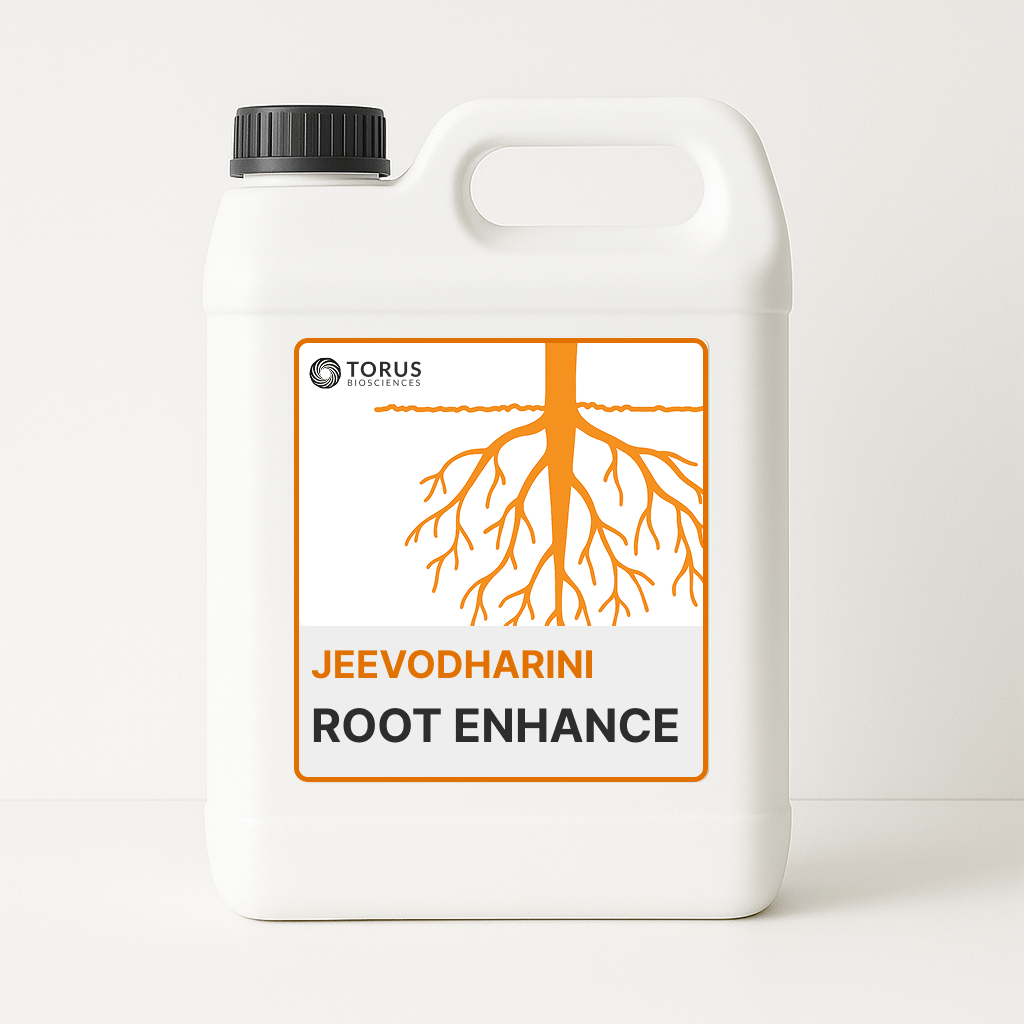
Jeevodharini Root Enhance
A specialized microbial formulation that protects root systems from pathogens while stimulating enhanced root architecture and function.

Jeevodharini Root Enhance simultaneously protects against soil-borne pathogens while promoting robust root development. This dual-function bioformulation uses specialized beneficial fungi that antagonize pathogens through competition, mycoparasitism, and antifungal metabolites, combined with beneficial rhizobacteria that stimulate root proliferation and enhance stress resilience.
Field trials consistently show significant reductions in root disease incidence alongside improved root structure and function, resulting in enhanced nutrient acquisition and stress tolerance. Root Enhance transforms vulnerable root zones into protected, biologically active growth centers supporting optimal plant development.
Benefits
-
Comprehensive Root Disease Management: Protects against major root pathogens including Pythium, Rhizoctonia, Fusarium, and Sclerotium through multiple mechanisms. Field evaluations show 70-85% reduction in damping-off incidence in vegetable seedlings and 50-65% decrease in root rot severity across various crops. The combined action of the fungal and bacterial components creates more complete protection than either organism alone.
-
Enhanced Root Architecture Development: Significantly improves root structure by stimulating primary root elongation and lateral root formation. Controlled studies document 35-55% increases in total root length, 40-60% greater root branching, and 30-45% increased root dry weight in treated plants, providing greater nutrient absorption capacity and improved anchoring strength.
-
Improved Propagation Efficiency: Enhances rooting success in vegetative propagation, reducing rooting time by 5-10 days while increasing rooting percentage by 30-45% in difficult-to-root species. The microbial phytohormones create optimal hormonal balance at cutting bases, promoting callus formation and adventitious root initiation.
-
Transplant Stress Mitigation: Minimizes transplant shock with field evaluations showing 25-40% higher survival rates and 30-50% faster post-transplant growth. The microorganisms produce ACC deaminase that reduces stress ethylene levels while improving water and nutrient acquisition.
-
Rhizosphere Health Enhancement: Improves overall rhizosphere health by increasing beneficial microbial diversity. Long-term studies show regular application leads to suppressive soils with 40-60% lower pathogen counts and 20-35% higher beneficial microorganism populations, with benefits persisting beyond a single growing season.
-
Reduced Chemical Input Dependency: Provides an effective biological alternative to chemical fungicides. Multi-season trials show Root Enhance can replace or significantly reduce soil fungicide applications with equivalent or better disease control while maintaining higher soil microbial diversity, potentially saving 30-50% on soil disease management costs.
-
Post-Stress Recovery Enhancement: Accelerates root system recovery after environmental stress events. Treated plants regenerate 40-60% more new roots following stress compared to untreated plants. The beneficial fungi maintain activity even in stressed soil conditions, providing continuous protection when plants are most vulnerable.
-
Environmental Compatibility: Extensively tested and certified safe for humans, beneficial organisms, and the environment with no adverse effects on soil fauna, pollinators, or non-target organisms, making it suitable for sustainable and organic production systems.
Suitable Crops
-
Vegetable Crops: Provides significant protection against damping-off and root rots in susceptible crops. Field trials in commercial production systems show 65-80% reductions in seedling mortality and 20-30% yield increases. Particularly effective in nurseries where treated seedlings establish 7-10 days faster than untreated controls.
-
Nursery and Ornamental Production: Improves propagation success rates with 35-55% higher rooting percentages in challenging species like poinsettia and woody ornamentals, with rooting time reduced by up to 40%. Particularly valuable in high-humidity propagation environments.
-
Fruit Trees and Orchards: Enhances establishment success with long-term studies showing saplings develop 25-40% more extensive root systems within the first growing season, improving anchorage, drought tolerance, and accelerated productive capacity. Particularly valuable in preventing replant diseases.
-
Plantation Crops: Provides protection and growth enhancement in coffee, tea, rubber, and banana with 30-45% reductions in root disease incidence and 20-35% improvements in early growth parameters, contributing to better establishment in marginal soils.
-
Pulse and Legume Crops: Offers effective protection against root and collar rots with research trials showing 40-60% reductions in root rot severity and 15-25% yield improvements. The fungal component shows compatibility with nitrogen-fixing bacteria.
-
Tuber and Root Crops: Enhances productivity in potato, sweet potato, and carrot with 25-40% reductions in soil-borne diseases and significant improvements in tuber quality and marketable yield through enhanced nutrient acquisition.
-
Hydroponics and Soilless Culture: Provides protection in vulnerable soilless systems where pathogens can spread rapidly. Research shows regular application maintains root health even in recirculating systems, reducing disease outbreaks by 50-70% compared to untreated systems.
Disease Management Capability
-
Damping-off Diseases: Provides exceptional protection against pre- and post-emergence damping-off. The beneficial fungi physically occupy infection sites while producing antibiotics that create a protective zone. Nursery trials document 75-90% reductions in damping-off incidence with visible colonization of growth medium within 3-5 days.
-
Root and Crown Rots: Prevents major root rot diseases across diverse crops. The combined action of fungal mycoparasitism and bacterial antibiotic production creates multiple barriers against pathogen establishment. Field studies show 50-70% reductions in root rot severity with microscopy confirming direct parasitism of pathogen structures.
-
Collar and Stem Base Diseases: Controls diseases at the critical soil-stem interface including southern blight, collar rot, and basal stem rot. Research demonstrates 60-75% reductions in collar rot incidence in susceptible crops when treated preventively.
-
Cutting and Propagation Diseases: Prevents rotting during propagation with commercial nursery trials showing 30-50% reductions in cutting losses and 40-60% improvements in rooting quality, particularly in high-value ornamentals and fruit crop propagation.
-
Transplant-Related Root Diseases: Mitigates diseases that attack plants during transplanting when root damage creates infection opportunities. Studies document 25-45% higher survival and 30-50% faster establishment in treated plants across diverse cropping systems.
For maximum effectiveness, apply Root Enhance preventively – as a seed treatment, rooting dip for cuttings, or soil drench during transplanting. Works synergistically with Growth (for enhanced nutrition) and Immuno (for improved plant defense).
Key Microorganisms
Our proprietary microbial consortium combines carefully selected beneficial microorganisms with complementary functions. It includes specialized fungal strains with exceptional root colonization capability that rapidly establish on root surfaces. These fungi produce hydrolytic enzymes (chitinases, β-1,3-glucanases, proteases) that degrade pathogen cell walls, reducing pathogen populations by 65-85% through direct mycoparasitism. They also produce over 100 documented antibiotic compounds that create inhibition zones around roots. The fungal component establishes within 48-72 hours after application, providing immediate protection.
The consortium also contains specifically selected beneficial bacteria that synthesize plant growth regulators (auxins, gibberellins, cytokinins) at biologically significant concentrations (10-30 μg/ml). These stimulate lateral root formation and root hair development, increasing root surface area by 40-60%. Additionally, the bacterial component produces cyclic lipopeptides that disrupt pathogen cell membranes and trigger induced resistance. Its endospore-forming capability ensures long-term persistence under variable environmental conditions.
Mechanism of Action
-
Competitive Rhizosphere Colonization: The microbial consortium rapidly establishes on root surfaces and surrounding soil within 48-72 hours, creating a physical barrier that prevents pathogen access through competitive exclusion.
-
Direct Mycoparasitism: The beneficial fungi actively locate and parasitize pathogenic fungi through a sophisticated detection system. They sense pathogen-produced volatiles, grow toward pathogen hyphae, and attach to them using specialized structures (appressoria) that penetrate pathogen cell walls using mechanical pressure and hydrolytic enzymes, reducing pathogen populations by 65-85%.
-
Antimicrobial Compound Production: Both microorganisms produce diverse antimicrobial compounds. The bacterial component synthesizes lipopeptides that disrupt pathogen cell membranes while the fungal component produces specialized antibiotics. These compounds maintain effectiveness even at low concentrations, creating continuous protection in the root zone.
-
Phytohormone Regulation: The beneficial microbes produce and modulate plant hormones to stimulate root development. The bacterial component synthesizes auxins at concentrations of 10-30 μg/ml, while both organisms influence cytokinin and gibberellin levels. They also produce ACC deaminase that reduces ethylene levels, promoting root elongation.
-
Root Structural Enhancement: Microbial interaction triggers enhanced deposition of structural compounds in plant cell walls with 30-50% increases in lignin, callose, and phenolic compounds, creating physical barriers against pathogen penetration.
-
Defense Enzyme Activation: Root Enhance microorganisms trigger the plant’s defense enzyme systems with 3-5 fold increases in peroxidase, polyphenol oxidase, phenylalanine ammonia-lyase, and chitinase within 72 hours of treatment, activating the plant’s internal immune response.
-
Nutrient Acquisition Enhancement: The microorganisms improve nutrient availability with the bacterial component producing organic acids and phosphatases that solubilize phosphorus, while the fungal component releases siderophores that mobilize iron and micronutrients. Research confirms 25-40% improvements in nutrient uptake in treated plants.
-
Stress Response Modulation: The microbial consortium helps plants tolerate environmental stresses by regulating stress response pathways, explaining the observed 30-45% improvements in recovery after drought, temperature extremes, or salinity exposure.
Storage and Usage Instructions
For detailed application instructions, please refer to our Root Application Guide. This product is most effective when applied directly to the root zone or used as a soil drench. For maximum benefits:
- Store in a cool, dry place between 4-25°C away from direct sunlight
- Shake bottle well before use to ensure even distribution of microorganisms
- Follow recommended application rates for your specific crop and growing conditions
- Do not mix with chemical fertilizers, pesticides, or fungicides in the same tank
- Apply during early morning or late evening to maximize microbial survival
Available Variants




Boost productivity with our sustainable biological solutions.
Trusted by agricultural and waste management professionals for superior results.
Request pricing & availability